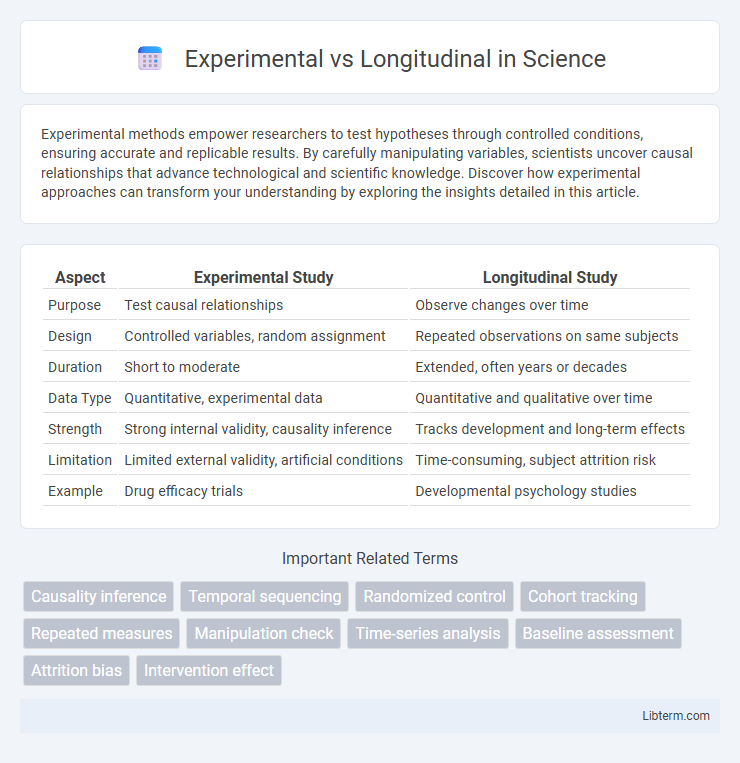Experimental methods empower researchers to test hypotheses through controlled conditions, ensuring accurate and replicable results. By carefully manipulating variables, scientists uncover causal relationships that advance technological and scientific knowledge. Discover how experimental approaches can transform your understanding by exploring the insights detailed in this article.
Table of Comparison
| Aspect | Experimental Study | Longitudinal Study |
|---|---|---|
| Purpose | Test causal relationships | Observe changes over time |
| Design | Controlled variables, random assignment | Repeated observations on same subjects |
| Duration | Short to moderate | Extended, often years or decades |
| Data Type | Quantitative, experimental data | Quantitative and qualitative over time |
| Strength | Strong internal validity, causality inference | Tracks development and long-term effects |
| Limitation | Limited external validity, artificial conditions | Time-consuming, subject attrition risk |
| Example | Drug efficacy trials | Developmental psychology studies |
Understanding Experimental Research
Experimental research involves manipulating one or more variables to determine causal relationships, offering high control over extraneous factors and precise measurement of effects. Longitudinal research tracks the same subjects over an extended period to observe changes and long-term effects but lacks the immediate control present in experimental designs. Understanding experimental research is crucial for establishing cause-and-effect connections through randomized assignment and controlled interventions, distinguishing it from observational study methods.
Defining Longitudinal Studies
Longitudinal studies involve repeated observations of the same variables over extended periods, allowing researchers to track changes and developments in subjects. Unlike experimental designs that manipulate variables to determine causality, longitudinal research emphasizes monitoring natural progressions without intervention. This method is essential for understanding temporal dynamics, developmental trends, and long-term effects in fields such as psychology, medicine, and social sciences.
Key Differences Between Experimental and Longitudinal Designs
Experimental designs involve manipulating variables to establish cause-and-effect relationships, while longitudinal designs observe variables over extended periods to identify patterns and changes. Experimental research typically features random assignment and controlled conditions, whereas longitudinal studies track the same subjects without intervention across multiple time points. Data collection in experimental designs is often short-term and focused on immediate effects, contrasting with the long-term observational nature of longitudinal research.
Advantages of Experimental Research
Experimental research offers the advantage of establishing cause-and-effect relationships by manipulating independent variables while controlling extraneous factors. This method enhances internal validity through random assignment and controlled conditions, reducing potential biases. Compared to longitudinal studies, experimental research provides quicker results and clearer insights into causal mechanisms.
Benefits of Longitudinal Studies
Longitudinal studies offer significant benefits by tracking the same subjects over extended periods, allowing researchers to observe developmental trends and long-term effects with high temporal accuracy. This method reduces recall bias commonly found in cross-sectional experimental designs, providing more reliable data on how variables evolve. The ability to establish temporal sequences enhances causal inferences, making longitudinal studies invaluable for understanding progression and changes in health, behavior, and social phenomena.
Common Methods Used in Experimental Studies
Experimental studies commonly use randomized controlled trials (RCTs) to establish causal relationships by manipulating variables and observing effects in controlled settings. Methods such as laboratory experiments, field experiments, and quasi-experiments are frequently employed to test hypotheses with high internal validity. These approaches ensure precise control over confounding variables, enabling researchers to draw strong inferences about cause and effect.
Typical Approaches in Longitudinal Research
Longitudinal research typically employs repeated observations or measurements of the same variables over extended periods to track developmental trends and causal relationships. Common approaches include panel studies, where the same subjects are surveyed multiple times, and cohort studies, which focus on groups sharing common characteristics to understand changes over life stages. These methods enable researchers to analyze temporal sequences and individual differences, offering insights that experimental designs with single time-point data collections cannot provide.
Data Collection Techniques: Experimental vs. Longitudinal
Experimental data collection techniques involve controlled manipulation of variables and random assignment to groups, enabling causal inference through structured interventions. Longitudinal data collection tracks the same subjects over extended periods, gathering repeated observations to analyze temporal changes and developmental trends. Experimental methods prioritize control and immediacy, while longitudinal approaches emphasize time-based data for understanding processes and outcomes over time.
Applications in Real-World Research
Experimental research designs allow for controlled manipulation of variables to establish causal relationships, making them ideal for testing interventions in clinical trials and lab-based psychology studies. Longitudinal research tracks the same subjects over extended periods, providing valuable insights into development, aging, or the long-term effects of treatments in fields like epidemiology and education. The real-world application of experimental methods excels in hypothesis testing and validation, whereas longitudinal studies are crucial for understanding temporal patterns and changes within populations.
Choosing the Right Method: Experimental or Longitudinal?
Choosing the right method between experimental and longitudinal research depends on the study's goals: experimental methods are ideal for establishing causal relationships through controlled manipulation and random assignment, while longitudinal approaches excel in observing changes over time and developmental trends. Experimental designs offer high internal validity but may lack ecological validity compared to longitudinal studies, which provide insights into temporal dynamics but are more vulnerable to attrition and confounding variables. Researchers must evaluate factors such as the need for causality, time constraints, resource availability, and the nature of the research question to select the most appropriate methodology.
Experimental Infographic

 libterm.com
libterm.com